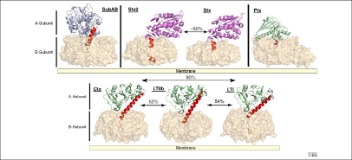Toxins
The development of DNA service protein GD5 is similar to TEG, however GD5 doesn’t incorporates ompA and KDEL. four shows Schematic representation of the GD5 fusion gene. Though therapeutic methods are creating quickly these days, some human diseases such as most cancers and AIDS are extremely tough to effect a radical treatment. Gene remedy cures ailments by using DNA that encodes a functional, therapeutic gene to switch a mutated gene.

Novel chimeras of botulinum neurotoxins A and E unveil contributions from the binding, translocation, and protease domains to their functional traits. Krantz, B.A.; Finkelstein, A.; Collier, R.J. Protein translocation through the anthrax toxin transmembrane pore is driven by a proton gradient. Similarly, Wang et al. made a chimeric botulinum toxin to focus on and suppress the discharge of the ache signaling peptide, calcitonin gene-related peptide , by sensory neurons. This distinctive specificity was achieved because of the properties of the three totally different chains of the chimera, which was composed of LCE fused to a mutated inactive form of LCA , both connected to the HCA that internalized the fused LCs in the cytosol . In this chimera, internalization was achieved as a result of sensory neurons categorical the HCA receptor isoform SV2C, however not the HCE receptor isoforms SV2A and B .
Detailed Learning Objectives
EGCG and PB2 thus appear to specifically disrupt CT-GM1 interactions, in distinction to the inhibition of LT-GM1 interplay ensuing from toxin precipitation with a minimal of seventy five μg/mL (a hundred sixty five μM) EGCG . Thermal unfolding of the free, lowered CTA1 subunit places it in a translocation-competent conformation for ERAD-mediated export to the cytosol . As our cocktail did not inhibit the temperature-induced shift of CTA1 to a protease-sensitive conformation, it might not block toxin translocation via a direct stabilizing effect on CTA1. However, the compounds might still inhibit toxin translocation via different mechanisms.
- The acquired immune deficiency syndrome inflicting virus HIV-1 makes use of its coat glycoprotein, gp120, to bind CD4 on the floor of leukocytes, including T helper cells and dendritic cells.
- Golgicide A, for example, was isolated in a excessive-throughput display screen for ST1 inhibitors and has been used to study toxin biology and the cell biology of vesicular transport .
- three.Low pH-induced conformational changes of the toxin induce insertion into the vesicle membrane and permit the translocation of part of the toxin across the vesicle membrane.
- This is of nice curiosity in muscle hyperactivation issues.
But DT with cell binding area at C-terminal and catalytic doamin at N-terminal, which is the inverse of ETA. Anthrax toxins, produced by Bacillus anthracis. In the case of the two anthrax exotoxins, two completely different A-elements known as lethal issue and edema issue share a typical B-component often known as protecting antigen . Protective antigen, the B-part, first binds to receptors on host cells and is cleaved by a protease creating a binding site for either deadly issue or edema issue. Lethal factor is a protease that inhibits mitogen-activated kinase-kinase. At low levels, LF inhibits the release of proinflammatory cytokines similar to interleukin-1 (IL-1), tumor necrosis issue-alpha, (TNF-alpha), and NO.